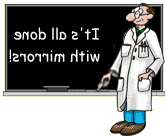
Solve the Riddle of Hidden Planets
Riddle: How
is playing a game of darts like looking for planets around
other stars? To
read the answer, hold a mirror to one side of your computer
monitor so that you see the monitor's image. Or print this
page and look at its reflection in a mirror. Answer: Catchy,
huh? But, Dr. Marc, what
does this strange answer mean? And
what do mirrors have to do with looking for other planets,
Dr. Marc? Well,
there are several excellent reasons. The optics (that is,
the mirrors or lenses that focus light) of a good telescope
must be nearly perfect. The mirror or lens must be just the
right shape and the surface must be perfectly smooth and
polished. In the case of a lens, even the inside must be
perfect. Otherwise, the image appears distorted. Also, the
larger the light-gathering surface (that is, the lens or
mirror), the brighter the image. The brighter the image, the
fainter the stars that can be seen.

![]()
 Almost all telescopes nowadays use mirrors, not lenses, to
gather and focus the light from celestial objects. We have
just seen, though, that mirrors reverse the image. The
riddle's answer you saw on your monitor (or paper) looks
very different from its image in a mirror. So why use
mirrors?
Almost all telescopes nowadays use mirrors, not lenses, to
gather and focus the light from celestial objects. We have
just seen, though, that mirrors reverse the image. The
riddle's answer you saw on your monitor (or paper) looks
very different from its image in a mirror. So why use
mirrors?
 A
lens (like in a pair of eyeglasses or a magnifying glass)
must be very large and very thick (thus very heavy) if it is
to be very powerful. Not only must the front and back
surfaces be perfect, but the inside must also be perfect,
because the light passes through the whole lens. Any flaws
in the lens will ruin the image--like looking through some
kinds of shower doors or warped windows.
A
lens (like in a pair of eyeglasses or a magnifying glass)
must be very large and very thick (thus very heavy) if it is
to be very powerful. Not only must the front and back
surfaces be perfect, but the inside must also be perfect,
because the light passes through the whole lens. Any flaws
in the lens will ruin the image--like looking through some
kinds of shower doors or warped windows.
The
StarLight space interferometry mission will use mirror
telescopes mounted on two spacecraft "flying in formation"
around the sun. Mirrors, by the way, since they are much
lighter weight than lenses, are a lot easier to boost into
orbit, too, whether Earth orbit or solar (sun) orbit.
StarLight will test the technology of interferometry in
space, so we can develop more missions to look for planets
around other stars and make other important and fascinating
astronomical measurements. Read
Dr. Marc's amazing
facts about StarLight and the technology of
interferometry.
 A
mirror, on the other hand, can be very thin, even if it is
large, as long as it has the right curved shape. And there
is only one surface to clean and polish. It is much easier
to make a large, near-perfect mirror than to make a large,
near-perfect lens.
A
mirror, on the other hand, can be very thin, even if it is
large, as long as it has the right curved shape. And there
is only one surface to clean and polish. It is much easier
to make a large, near-perfect mirror than to make a large,
near-perfect lens.
|
|
|||||





